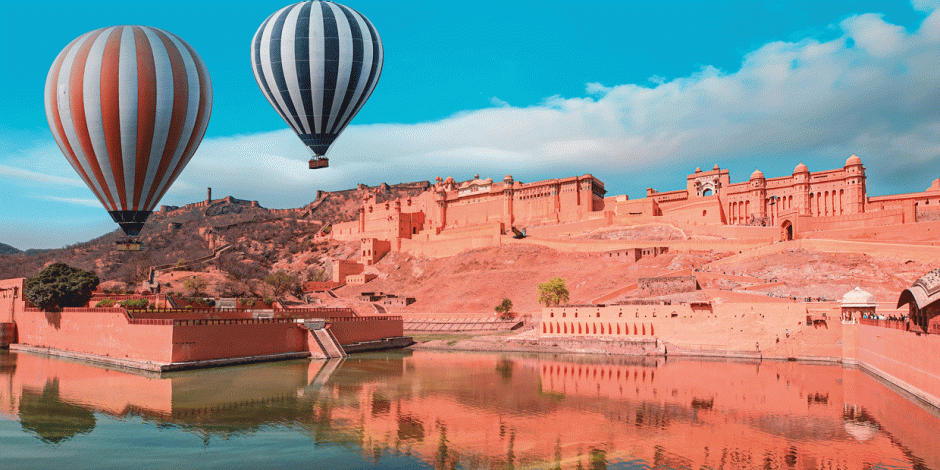Starten Sie den Audio-Text
Mit dem Audio-Player können Sie sich den Text anhören. Darunter finden Sie das Transkript.
Transcript: Rajasthan: sustainable tourism
Rajasthan has become the modern face of India. Its growing business environment has made the region a leader in the green energy revolution, especially in the development of solar parks and wind farms.
In spite of its rapid modernization, Rajasthan’s rich culture continues to capture the imagination. Tourism is a huge and ever-growing industry. The region’s world-class palace hotels, World Heritage SiteWeltkulturerbe World Heritage Sites and elegant temples are so famous that it’s easy to plan a trip. However, the emphasis is nowadays on sustainablenachhaltigsustainable travel – ecotourism – with companies offering not only desert safaris, but also mountain adventures, such as paragliding, zip-liningSeilrutschenzip-lining, hiking and e-bike tours, which protect the natural habitatLebensraumhabitat of wildlife as well as local communities.
Here’s a guide to exploring timeless favourites, along with some of Rajasthan’s new attractions.
Jaipur: upcycling textiles for designer fashion
In 1876, Maharaja Sawai Ram Singh of Jaipur had the whole city painted pink to welcome Queen Victoria’s eldest son, the Prince of Wales, during his tour of India. Pink was considered the colour of hospitalityGastfreundschafthospitality at that time.
Since then, all buildings in India’s first planned city must be painted “Jaipur pink” – every home, temple, bazaar and public building. The most famous of these is probably the Hawa Mahal. Built from red sandstone in 1799, this palace was painted pink in 1876 for the Prince of Wales’s visit. An exception to the pink rule is the Jantar Mantar observatoryObservatoriumobservatory, dating back to the early 1700s and home to the world’s largest sundialSonnenuhrsundial.
The culture of hospitality flows into Jaipur’s exquisite textiles. Designers from around the world come to the Kishanpole Bazaar, or visit the Chippa Mohalla textile printing area in the town of Bagru, to choose tie-dyedmit Falten- und Abbindetechnik gefärbttie-dyed (bandhani) and hand-block-printed (Bagru) cotton and silk.
Helping to bring Jaipur’s textile industry into the age of climate change and responsible design is 28-year-old Bhaavya Goenka’s sustainable fashion label: Iro Iro. Goenka grew up at her parents’ clothing factory in Jaipur and used to watch the heavy trucks filled with unused textiles being taken to landfillMüllkippelandfills. In 2017, she started Iro Iro, with the aim of reuse sth.etw. wiederverwertenreusing textile waste. Her team has “upcycled” about five tonnes of cotton, linenLeinenlinen and pieces of denim into handcrafted fabrics, generating work for 20 artisan (Kunst)Handwerker(in)artisans and making this a brand to watch.
Udaipur: the growth of sustainable tourism
In the Mewar region of south-central Rajasthan, Udaipur is like a vision in the desert. The city’s rare beauty centres around its famous lakes, with the surrounding Aravalli Hills separating it from the Thar Desert.
The hilly landscape and hiking trails in and around Udaipur offer a wealth of exciting things to do. Rajsamand Lake, which was established in 1660, is an upcoming spot for paragliding. The Chirwa Ghata valley is being developed as a zip-lining destination, far from the tourist crowds.
The city’s sustainable ecosystem is rising to new heights with Strode Experiences. Started by Udaipur-born Namit Jain, the company offers e-bike adventures at unusual locations across India. With Udaipur as its launch city, Strode takes visitors to spots they probably wouldn’t otherwise see – such as up the zigzag road to Monsoon Palace, above the Sajjangarh Wildlife sanctuarySchutzgebietSanctuary, or to the green Rayta Hills, where visitors get an adrenalin rushAdrenalinschubadrenalin rush on an e-bike trail (about 40 kilometres from the city by road).
One of their most exciting offerings is a trip to a local ranch and the chance to ride a majestic Marwari horse (there are just 1,000 of them left in the world). The origins of this hardyausdauernd, robusthardy breedRassebreed, with curly earsSichelohrencurly ears that rotate up to 180 degrees to touch at the tips, are said to be to trace sth. back to sth.etw. auf etw. zurückführen lassentraced back to Maharana Pratap’s white stallionHengststallion Chetak, who, although wounded in battle in 1576, is said to have carried Pratap to safety before dying.
A booking with Strode can also take you to a small studio in a narrow lane in the city of Udaipur, where a family practises Jal Sanjhi (water painting), the rare temple art of stencillingSchablonenmalereistencilling Landschaftsbildpastoral scenes from the life of the god Krishna, using organic colours on water. This family has been keeping the art of Jal Sanjhi alive for generations; they’re the only people still doing it.
Neugierig auf mehr?
Dann nutzen Sie die Möglichkeit und stellen Sie sich Ihr optimales Abo ganz nach Ihren Wünschen zusammen.



